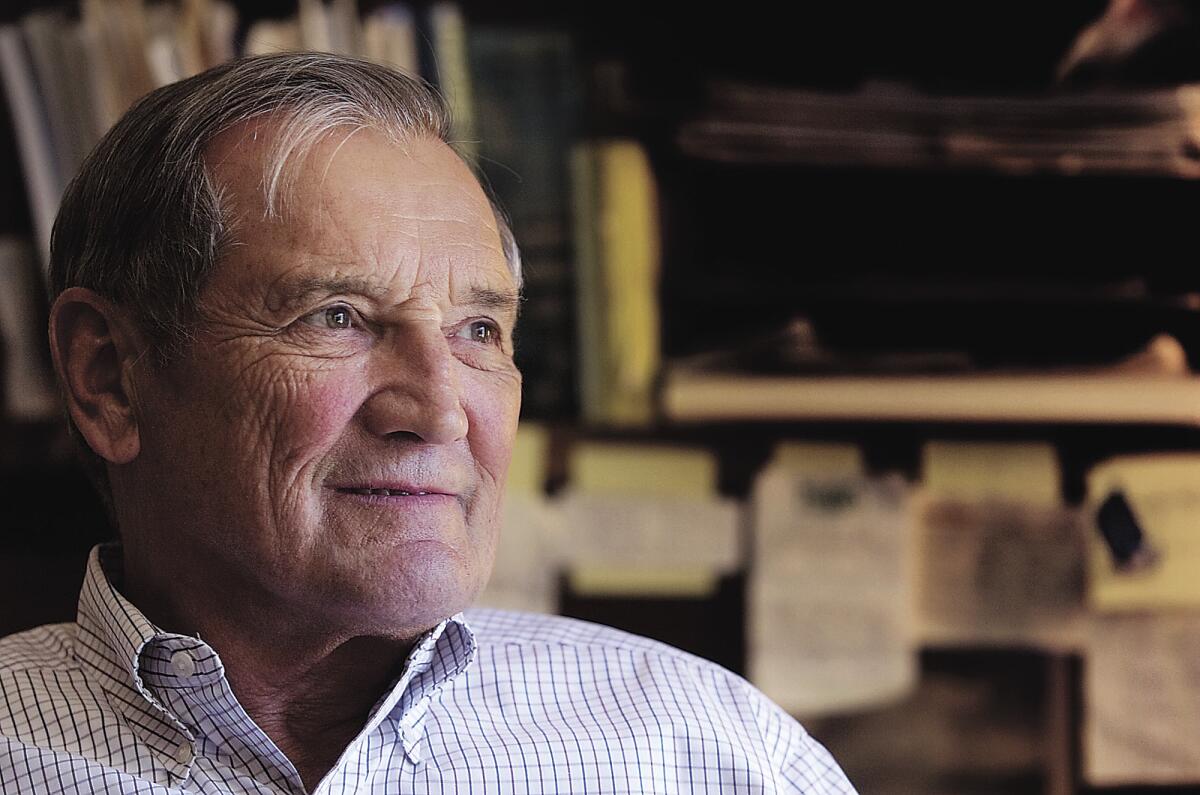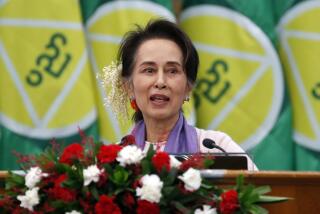Veteran’s detention in North Korea highlights wartime guerrilla unit

BEIJING -- Merrill Newman is the newest POW from the Korean War -- no matter that the war ended 60 years ago.
The 85-year-old veteran and retired tech executive from Palo Alto was arrested Oct. 26 at the end of a 10-day visit to North Korea.
After a month of holding him incommunicado, the North Koreans on Saturday released a videotaped confession from Newman, revealing details of clandestine and still partially classified anti-Communist guerrilla activities in which Newman was involved during and possibly after the 1950-1953 war.
Without comment on the strange allegations in the confession, the White House on Saturday called on North Korea to release Newman on humanitarian grounds.
“Given Mr. Newman’s advanced age and health conditions, we urge [North Korea] to release Mr. Newman so he may return home and reunite with his family,” said Caitlin Hayden, spokeswoman for the National Security Council.
[Updated at 6:58 p.m. on Nov. 30: Newman received his first official visit on Saturday in Pyongyang from the Swedish ambassador, who handles U.S. interests in North Korea in the absence of formal diplomatic relations.
“Merrill reports that he is being well-treated and that the food is good,’’ Newman’s family said in a statement released late Saturday. “We are asking that [North Korean] authorities take into account his health and his age and, as an act of humanitarian compassion, allow him to depart immediately for home.”]
Wearing a blue shirt and khaki trousers in the videotape and looking fit for his age, Newman read from a handwritten statement in which he said he had been an advisor to the Mt. Kuwol partisans, a U.S.-directed guerrilla unit that fought the North Koreans at the end of the war.
During his trip, he asked his North Korean guides for help locating survivors of the unit or their families who might still be living in North Korea, and passed on addresses and emails of veterans who had escaped to South Korea, according to the statement.
“Although I committed the indelible offensive acts against the Korean people in the period of the Korean War, I have been guilty of big crimes against the DPRK [North Korean] government and Korean people again,’’ the statement said.
The video showed Newman bowing slightly to the camera, signing the statement and sealing it with a thumbprint in red ink.
The case has dredged up ghosts of a war that never officially ended, having been settled only with the 1953 armistice.
“Most people in America look at the Korean War as 60-year-old news. Mr. Newman probably thought bygones would be bygones,” said Mark Sauter, a Washington-based historian who has written widely on the war and on POWs. “But to North Korea, the war is still going on. They take guerrillas and espionage very seriously because they are masters at it and are paranoid about it being done to them.”
What makes the case especially sensitive, Sauter said, is that the guerrilla activities directed by the U.S. military and later the CIA continued after the signing of the truce in June 1953.
“Just this year, I was at the National Archives trying to get documents about U.S. guerrillas in North Korea in 1954 and after,” Sauter said. “A lot of them are still classified. They won’t give them to me.”
The Mt. Kuwol unit was named for a mountain on the west coast of North Korea and was operated under the command of the U.S. Army’s 8240th unit, sometimes known as the “White Tigers,” according to the U.S. Army Military History Institute at Carlisle Barracks, Pa.
They often staged “commando-type shallow-penetration hit-and-run raids” against North Korean targets, operating from offshore islands. “American advisors with the units had the task of assisting these staffs in planning operations,” the institute states.
In his confession, which appears to have been written by a Korean because of the grammatical mistakes, Newman says he directed his units to “attack communications systems, rice storage, railroad and munitions” and that they were responsible for killing at least 50 North Korean soldiers as well as civilians.
Photographs released Saturday by the Mt. Kuwol Guerrilla Unit Comrade Assn. in Seoul and published by the Reuters news agency showed Newman in what appeared to be a recent visit to a war cemetery and memorial in Seoul.
After the Korean War, Newman remained in touch with the Koreans who were under his command, visiting them in South Korea and inviting them to his home in Palo Alto. He often wore a gold ring they gave him in September 1953 to thank him for his service.
His South Korean comrades told Reuters they were surprised Newman went to North Korea as a tourist.
“In the eyes of the North Koreans, he would have literally been a spy engaging in some kind of espionage activity. ... I wouldn’t go there [if I were him],” Kim Hyeon, an 86-year-old friend of Newman’s, told the news agency.
Newman is the seventh U.S. citizen to be arrested in North Korea in recent years, but the only one who came in as an ordinary tourist. Hundreds of Americans now visit North Korea each year on guided tours and there have been few incidents, according to Walter Keats, a tour operator based in Chicago.
“Mr. Newman had been in a unit in the war that the North was particularly unhappy with. It looks like he naively thought he could openly talk about this in the DPRK,” Keats said in an email.
Another U.S. citizen, Kenneth Bae, an ethnic Korean, has been held in North Korea for over a year for proselytizing and missionary work.
ALSO:
At least one dead in Thailand protests
Egypt panel votes on constitutional reforms
Death toll rises in crash of police helicopter into Glasgow bar
Twitter: @BarbaraDemick
More to Read
Start your day right
Sign up for Essential California for news, features and recommendations from the L.A. Times and beyond in your inbox six days a week.
You may occasionally receive promotional content from the Los Angeles Times.






